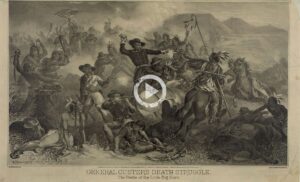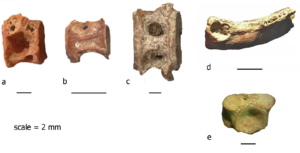Scholar Ned Blackhawk on the importance of tribal sovereignty and his new book ‘The Rediscovery of America’
The conventional telling of American history used to be painted in primary colors: a cheerful and triumphal narrative about an exceptional country. Over time, in at least some quarters, that telling became more complex, reframed around the struggle to make good on the promises of democracy. But even in that more nuanced narrative, Native Americans tend to be absent, as are their histories of struggle, survival, dispossession and self-determination.
In his new book, “The Rediscovery of America: Native Peoples and the Unmaking of U.S. History,” Ned Blackhawk, a professor at Yale University, confronts that absence. In its place, he offers a sweeping account of how Native Americans shaped the country legally, politically and culturally at every turn: from the earliest notions of self-governance held by British colonists, to the writing of the Constitution, to the westward expansion that would seed the Civil War and beyond.
We spoke in April, the day his book was released. At the time, the Supreme Court was still deciding Haaland v. Brackeen, about a 1978 law that, in foster care and adoption of Native American children, gave preference to their relatives and tribes. On Thursday, the Supreme Court decided 7-2 in favor of the tribes, who had argued that the law concerned political distinctions rather than racial ones. The case concerned questions at the core of Native American history, questions that Blackhawk, in his book, places at the center of American history as a whole.
This conversation has been edited for length and clarity.
Growing up, do you remember what you were taught about Native history? What was emphasized, and what was missing?
I think my experience is very similar to others, in that there was no content. I think that is still by and large the experience of the vast majority of American schoolchildren. I did take AP history in high school which, I won’t brag, but I did very well and the instructor at the time said, “We don’t need to study the colonial period because it never shows up on the exam itself.” These things are starting slowly, in certain places, to get reformed, but not very consistently. In that process, we have to unmake a lot of the assumptions we’ve been handed.
So we’re trying to rethink American history, to move away from, in particular, an exclusively binary racial model. Major scholars continue to talk about slavery as the original sin of America, as the foundational American institution, as the exclusive form of racial discrimination or subordination, leaving aside the fact that hundreds of thousands of American Indians were enslaved throughout the colonial era.
How the Advanced Placement curriculum undermined its original goals
It seems like, in popular history, there is movement away from a purely triumphal account of the founding of the United States, but I think people implicitly see Native history as a tragic backdrop to other events. What do we gain when we see it as central to early American life?
Chapter Five, “The Settler Uprising: The Indigenous Origins of the American Revolution,” is focused on what I call the interior Ohio River headwaters area. There is lots happening there that illuminates central elements of the larger American story, elements that we have not sufficiently been told. These elements include not just the intense vilification of Native Americans as the principal antagonists of the British colonial world, but more importantly, the central influence that Native peoples had upon the formation of American national identity.
We have to understand what the Founders did in response to that influence. What they did, in part, was to change the form of their government. We are woefully miseducated in our country about these early years of the republic. But if we return to these periods, we will see very clearly the formative presence of Native peoples, interior lands and what was then called “the crisis of 1783” on the subsequent structure of the American state.
In that structure, Indians have a particular place and constitutional standing. This is one of the deeply complicated and misunderstood underpinnings of American legal and political history: the place of the Indigenous peoples within the United States. What is that place? That place in part was created by Native peoples forcing themselves into the structure and practices of the American government, which created more of a federalist system in 1787 than what existed during the revolutionary era.
In that system, Indians occupy an exclusively federal relationship with the American state. They are not citizens, because they are excluded in the Constitution. They are excluded in the 14th Amendment. They are excluded in the Civil Rights Act of 1866. The federal government then maintains, ideally, bilateral political relationships that are diplomatic, legal and political with Native nations. They sign treaties with them. These treaties, according to this Constitution, are the supreme law of the land.
This is a huge tension in the early republic, because the revolution had been about liberty, popular sovereignty, representative government. We live in a world in which Native nations have constitutional standing that is distinct from that of other U.S. citizens. Very few political scientists, very few law school professors, very few historians have the training or the vernacular to talk about these subjects.
My sense is that the general public engages most with Native experience in terms of individual identity and usually in racial terms. I don’t think it is common yet to talk about things through the lens of sovereignty, as a political and legal concept. Do you have a sense of where that reflex to look at things in racial terms, instead of in terms of the state, comes from?
This is one of the deep paradoxes of our intellectual moment in many ways. We’ve come to see the struggle for minority protection as a struggle for individual rights. So if we can obtain the right to vote, the right for mobility, the freedom of speech and religion, we believe we have entered into the universalist political discourse and structure of our nation’s initial, expressed principles, which are beautiful.
Bite off a hunk of history with one of these new books
However, Indian sovereignty is also a beautiful idea. It is also a political commitment that the Founders made, and one that Native nations have worked to uphold since, and even before, the founding. They lost, often, that struggle. You can’t find articulated general understandings of these things very easily. If you know anything about the history of federal Indian policy, you know that any time Congress sneezes, Indians end up in the hospital.
When the broader society moves away from this form of recognition and moves into a space of pity or disdain or discomfort with Indigenous realities, they start instituting new initiatives. And those new initiatives sound like this: Let’s take their children away from them. Let’s send them to boarding schools where they can no longer learn anything about their families and traditions and cultures, and learn the new American way. Let’s “kill the Indian and save the man,” as Richard Pratt, the founder of the Carlisle Institute, would say.
You said that sovereignty is a beautiful concept. When you are talking to colleagues or students or readers, for that matter, what do you tell them about sovereignty and what is beautiful about it?
Sovereignty is not something that is unilaterally maintained. So Native American sovereignty is established bilaterally. That’s what sovereignty is. It’s not independence. It’s a mutually established doctrine and practice of U.S. constitutional law that ideally recognizes these inherent rights of Native peoples to govern themselves and administer their tribal lands and resources, ideally in concert with the federal government, so housing, educational assistance, health care and medical services, can be costewarded. That’s what Indians, in a sense, fought for.
I wondered about the research or method challenges you encounter when constructing earlier history. How do you balance the recorded words of Europeans and conveying Native perspectives of the same events?
I’ll try to be pretty succinct here: Native peoples enabled the survival of all European settlements in North America. That survival is embedded in the textual records of all colonial leaders and settlements. The harder subjects to get at are the interior worlds in which Native peoples lived and traded, and fought for, died in defense of, against intrusion: diseases, intertribal warfare, disruptions of a really apocalyptic form. But scholars have been rediscovering this material for half a century, and they have left behind a vast library of studies that can really point us in certain, clear directions.
A new history of Indigenous America that replicates old myths
In the last few years, there has been more popular awareness of ambitious Indigenous history books trying to correct the conventional narrative of American history and to place Native power and agency at the center. What do you make of this moment and what do you think was missing from some of those narratives?
There have been relatively few single-volume interpretations of Native American history. It’s very obviously a vast subject, both in time and space as well as cultural and political diversity. California itself has more than 100 federally recognized tribes and once was the most densely populated part of native North America. So it’s really hard to fashion paradigms to make sense of a whole, out of a series of often regional studies. I think we need continued engagement with these subjects, and I would be happy to see subsequent efforts carry forward, challenge and remedy perhaps the omissions this one book has.
But I think any work that undertakes this type of interpretive engagement obviously has to do so with that kind of cautious understanding that we’re not looking for easy and quick answers at the moment. For example, I reviewedDavid Treuer’s “The Heartbeat of Wounded Knee,” where he took issue with the emphasis of victimization implied by Dee Browne’s famous book, “Bury My Heart at Wounded Knee.” That’s a good start to make the emphasis on life rather than death.
A note to our readers
We are a participant in the Amazon Services LLC Associates Program, an affiliate advertising program designed to provide a means for us to earn fees by linking to Amazon.com and affiliated sites.




